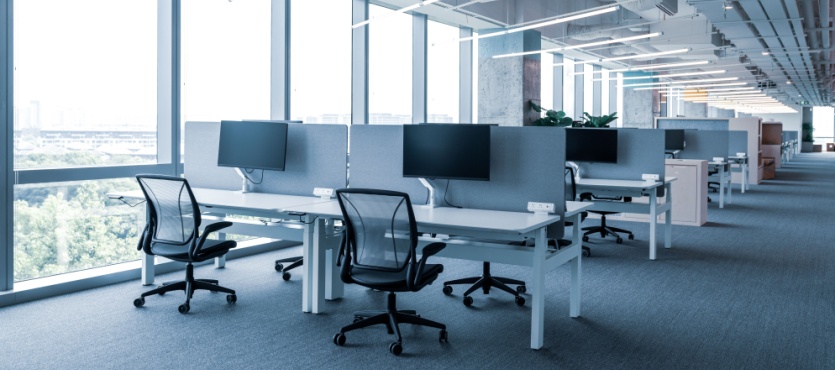Office lighting is one of the most powerful—and most overlooked—elements in workplace design. While layout, furniture, and technology often take center stage, lighting has a profound impact on how employees feel, focus, and perform throughout the day. Poor lighting can lead to eye strain, headaches, and fatigue, while thoughtful, well-designed lighting enhances concentration, mood, and energy levels. As more companies prioritize employee well-being and productivity, it’s clear that lighting should be a central part of any office renovation or build-out plan.
The Connection Between Light and Performance
Human beings are naturally sensitive to light. It influences our circadian rhythm—the internal clock that regulates our sleep-wake cycle—and plays a crucial role in cognitive function, alertness, and mood. In work environments, the right lighting can make the difference between sluggishness and sustained productivity.
Studies have shown that employees exposed to adequate natural light during the workday report higher levels of alertness, better sleep quality, and reduced absenteeism. In contrast, dim or overly harsh lighting can lead to mental fatigue, low energy, and even long-term health concerns. As such, lighting isn’t just a matter of aesthetics—it’s an essential tool for supporting workplace performance.
Maximizing Natural Light
One of the best ways to improve lighting in an office is by maximizing access to natural light. Windows, skylights, and open floor plans that allow sunlight to reach deeper into the space can have significant benefits for productivity and morale.
Design strategies for increasing natural light include using glass partitions instead of solid walls, placing workstations near windows, and selecting light-colored finishes that reflect sunlight throughout the space. While it’s not always possible to rely solely on daylight—especially in larger or windowless offices—bringing in as much natural light as possible is always a smart starting point.
Layering Light for Functionality
Effective office lighting involves more than just overhead fixtures. A well-lit workspace uses a layered lighting approach to balance ambient, task, and accent lighting:
Ambient Lighting provides overall illumination and sets the tone of the space. It should be even, glare-free, and comfortable for the eyes. LED ceiling panels and recessed lighting are common choices for this foundational layer.
Task Lighting targets specific work areas where focused lighting is needed—such as desks, conference tables, or collaborative zones. Adjustable desk lamps, under-cabinet lighting, or pendant fixtures over workstations ensure employees have enough light for detailed tasks without eye strain.
Accent Lighting adds visual interest and enhances the overall design of the office. While it may not directly impact productivity, it contributes to the mood and energy of a space—both of which affect how people feel at work. Accent lighting can include wall sconces, decorative fixtures, or strategically placed lights that highlight architectural features or company branding.
Color Temperature and Its Impact
Color temperature is another critical factor in office lighting design. Measured in Kelvins (K), color temperature determines whether a light source appears warm (yellow/orange) or cool (white/blue). In general, cooler temperatures (around 4000K–5000K) are better suited for work environments because they mimic natural daylight and help employees stay alert.
Warm lighting (below 3500K) creates a more relaxed atmosphere, which is ideal for lounges, break rooms, or reception areas but can lead to drowsiness in task-oriented spaces. By selecting the right color temperature for each zone, businesses can enhance both function and ambiance.
Avoiding Common Lighting Mistakes
While designing an effective lighting plan, it’s important to avoid common pitfalls. Overhead fluorescent lights, for instance, can create harsh, flickering illumination that causes discomfort. Poor placement of fixtures can result in uneven lighting, shadows, or glare on screens, all of which contribute to eye strain and distraction.
Another frequent issue is relying on a single lighting type for the entire office. Uniform lighting may seem efficient, but it doesn’t account for the diverse tasks employees perform throughout the day. Thoughtful zoning and layered lighting create a more adaptable environment that responds to different needs and preferences.
Smart Lighting for Smarter Workplaces
Smart lighting systems are an increasingly popular option in modern offices. These systems use sensors, timers, and automation to adjust lighting based on occupancy, time of day, or available natural light. Motion sensors can reduce energy consumption by turning off lights in unoccupied rooms, while daylight sensors dim or brighten fixtures in response to sunlight levels.
Some systems allow employees to control lighting levels at their individual workstations through apps or wall-mounted controls, allowing for a more personalized and comfortable experience. By combining efficiency with flexibility, smart lighting enhances both sustainability and user satisfaction.
Lighting as a Design Investment
Investing in a high-quality, well-planned lighting system is an investment in your people. It supports productivity, reduces workplace fatigue, and creates a welcoming, energized environment that reflects your company’s values and attention to detail. Lighting design should never be an afterthought—instead, it should be integrated into the early planning stages of any office renovation or build-out to ensure the best possible outcomes.
Illuminate Your Office, Empower Your Team
Lighting is more than a utility—it’s a driver of workplace performance. From maximizing natural light and choosing the right fixtures to integrating smart controls and selecting the right color temperature, every decision shapes how employees feel and function throughout the day.
If your office lighting needs an upgrade or you’re planning a renovation that prioritizes employee productivity, working with professionals who understand the nuances of lighting design can make all the difference. To get started, visit Perillo Construction’s Contact Us page and discover how an expertly designed space can light the way to better work.

